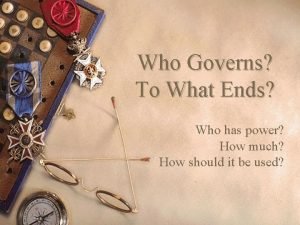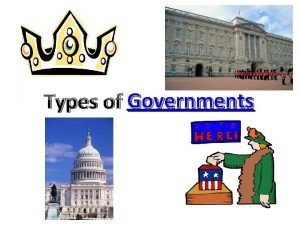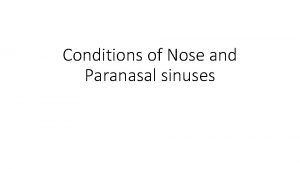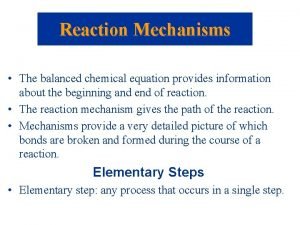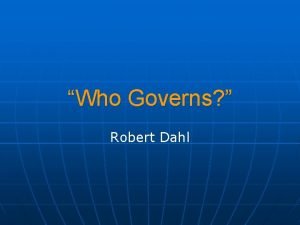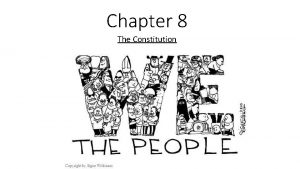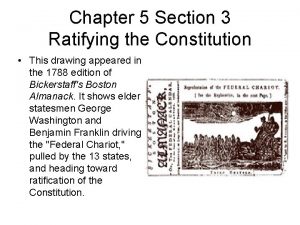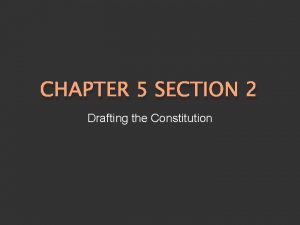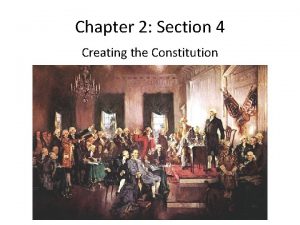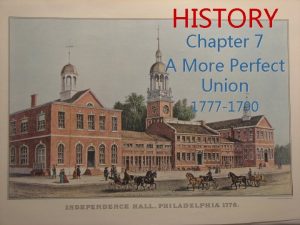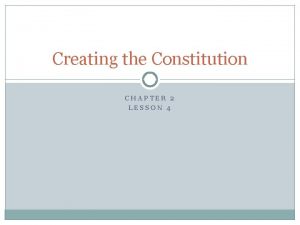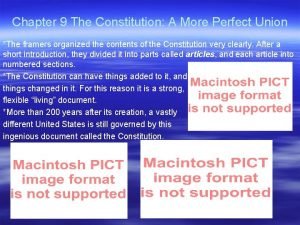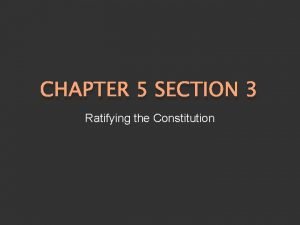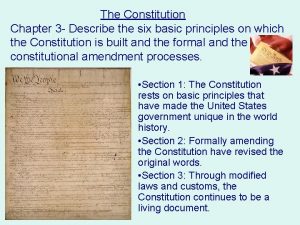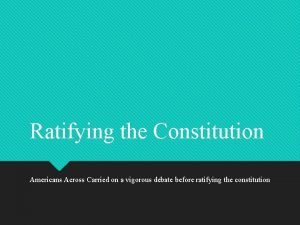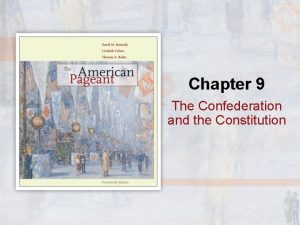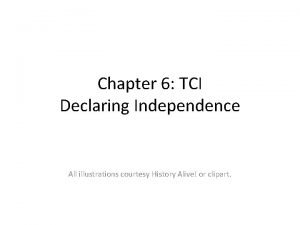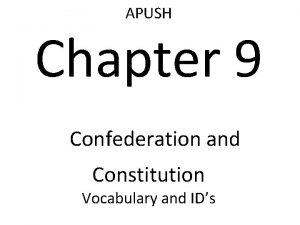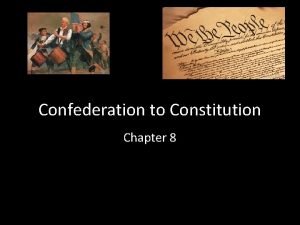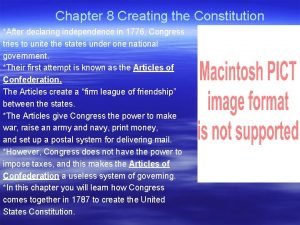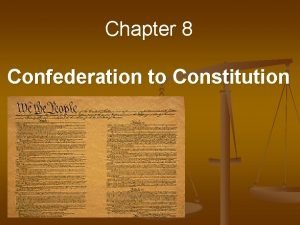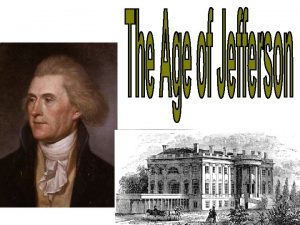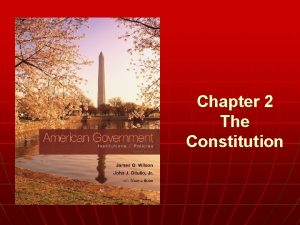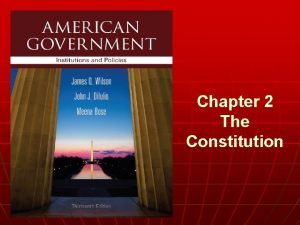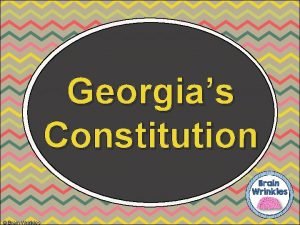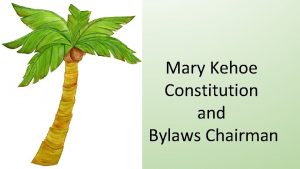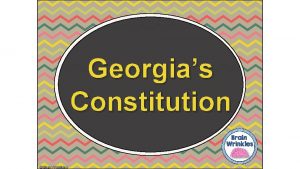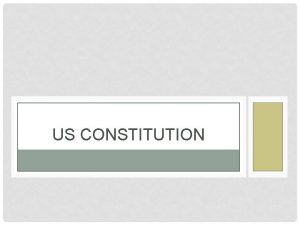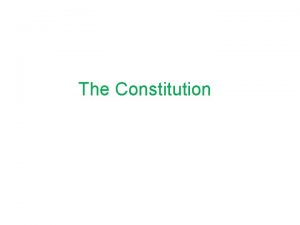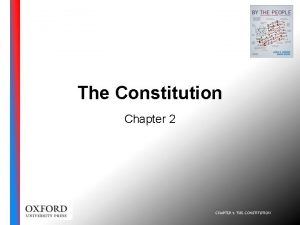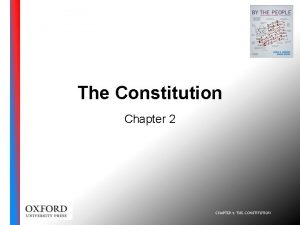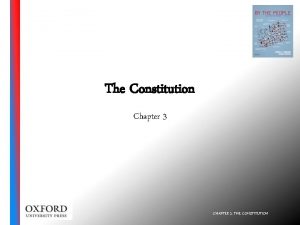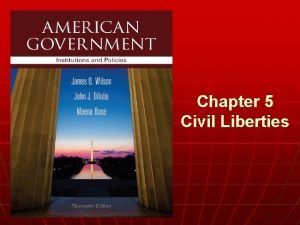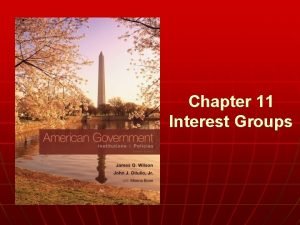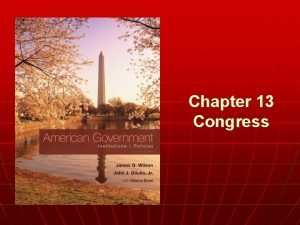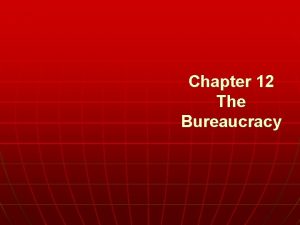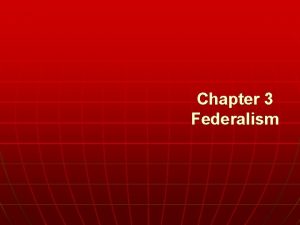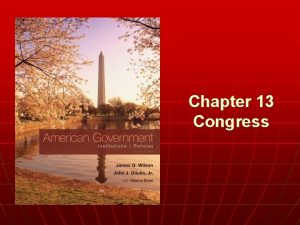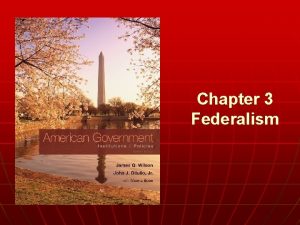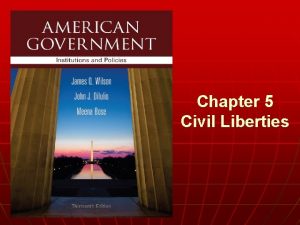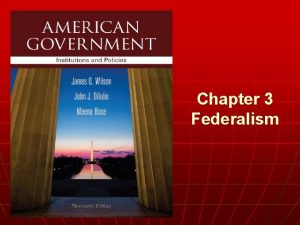Chapter 2 The Constitution n WHO GOVERNS 1














































- Slides: 46

Chapter 2 The Constitution

n WHO GOVERNS? 1. What is the difference between a democracy and a republic? 2. What branch of government has the greatest power? n TO WHAT ENDS? 1. Does the Constitution tell us what goals the government should serve? 2. Whose freedom does the Constitution protect? Copyright © 2013 Cengage

Copyright © 2013 Cengage

The Problem of Liberty n The Colonial Mind • Men will seek power because they are ambitious, greedy and easily corrupted n n The Real Revolution Weaknesses of the Confederation • The Articles of Confederation went into effect in 1781 • Problems quickly surfaced in trade, currencies and lack of tax money to pay war debts and Continental soldiers Copyright © 2013 Cengage

First Continental Congress n n n Met after the Intolerable Acts were passed to punish Massachusetts for the Boston Tea Party The focus was to restore the political structure that was in existence before the passage of legislation affecting the internal operations of each colony by Parliament. Had the Crown and Parliament relented on many of their demands, the Declaration of Independence might never have been issued. Copyright © 2013 Cengage

Second Continental Congress n n n Met in May of 1775 (after Revolutionary War had begun) All 13 colonies attend this meeting Drafted the Declaration of Independence Drafted the Articles of Confederation Serves as the first acting national government of the U. S. Copyright © 2013 Cengage

© Poodles. Rock/Fine Art/Corbis Signing the Declaration of Independence, painted by John Trumbull. Copyright © 2013 Cengage

North America in 1787 Copyright © 2013 Cengage

Bettmann/CORBIS In 1775, British and American troops exchange fire in Lexington, Massachusetts, the first battle of the War of Independence. Copyright © 2013 Cengage

The American Revolution n n 1 st battle – April 18 -19, 1775 Lexington & Concord Last battle – Yorktown where Gen. Cornwallis surrendered to Gen. Washington on October 19, 1781 Washington’s strategy was to keep fighting and wear down the British Washington retires rather than being crowned the “King of the U. S. ” Copyright © 2013 Cengage

The Treaty of Paris of 1783 n n Negotiated by Benjamin Franklin American independence was recognized by the British As a result of this treaty, the new United States doubled in size! Great Britain ceded land west of the Appalachians to the Mississippi River (up to Canada and down to Florida) to the U. S. Copyright © 2013 Cengage

The Articles of Confederation n n n 1 st Constitution of the U. S. (1781 -1789) Created a “confederation” which is a loose association of INDEPENDENT states States began to quarrel over boundary lines & tariffs States began making treaties with foreign nations The new nation faced serious money problems (it owed $40 million to foreign governments & to unpaid American soldiers) No army for defense of states Shays’s Rebellion protest of unpaid soldiers Copyright © 2013 Cengage

Weaknesses of the Articles n n n n Congress could not collect taxes Congress could not regulate trade Congress could not force anyone to obey laws 9 out of 13 of the states were required to pass laws 13 out of 13 states required to amend the Articles No executive branch No Supreme Court or national court system Copyright © 2013 Cengage

Bettmann/Corbis Shays’s Rebellion in western Massachusetts in 1786– 1787 stirred deep fears of anarchy in America. The ruckus was put down by a hastily assembled militia, and the rebels were eventually pardoned. Copyright © 2013 Cengage

The Constitutional Convention Met in Philadelphia from May until Sept. of 1787 1. Given permission to “revise” and correct the Articles of Confederation (not write a new Constitution) 2. George Washington elected president of the Constitutional Convention 3. Proceedings kept secret to encourage free debate Copyright © 2013 Cengage

The Constitutional Convention n The Lessons of Experience • The State Constitutions • Shays’s Rebellion n The Framers • 55 delegates attended but 74 had been appointed • Rhode Island did not attend the Convention • Only 39 would sign it out of the 55 who attended Copyright © 2013 Cengage

The Challenge n The Virginia Plan–proposal to create a strong national government n The New Jersey Plan–proposal to create a weak national government n The Compromise • popularly elected house based on state population • state elected Senate, with two members for each state Copyright © 2013 Cengage

Andre Jenny/Alamy Independence Hall in Philadelphia. Copyright © 2013 Cengage

The Constitution and Democracy n Republican Form of Government • Key Principles Federalism n Enumerated powers n Reserved powers n Concurrent powers n n Government And Human Nature • Separation of powers • Checks and balances Copyright © 2013 Cengage

Ratifying the Constitution n The Constitution would go into effect when 9 out of 13 states ratified it By June of 1788, 9 states had ratified it but Virginia and New York had not ratified it yet The states were not sure that they wanted to give up their sovereignty to a strong central government again Copyright © 2013 Cengage

Federalists & Anti-Federalists Two groups quickly formed: 1. 2. Federalists led by Alexander Hamilton supported the Constitution & a stronger central government Business owners, merchants; welleducated and propertied class. Most lived in settled areas along the seaboard. Copyright © 2013 Cengage

Federalists 1. Articles of Confederation were weak and ineffective. 2. National government needed to be strong in order to function. 3. Strong national government needed to control uncooperative states. 4. Men of experience and talent should govern the nation. ("Mobocracy" threatened the security of life and property. ) 5. National government would protect the rights of the people. 6. Constitution and state governments protected individual freedoms without bill of rights. 7. In favor of establishing the Constitution with almost any means possible. 8. More sympathetic to separation of church and state. Copyright © 2013 Cengage

Federalists & Anti-Federalists n n The Antifederalists, led by Thomas Jefferson, feared a strong national government Backcountry farmers, poor farmers, the illeducated and illiterate, debtors, & papermoney advocates. For states’ rights “Extralegal” document (not sanctioned by law) It was drafted in secrecy Copyright © 2013 Cengage

Anti-Federalists 1. Favored the Articles of Confederation 2. Opposed strong central government. 3. Feared a strong national government would threaten state power. 4. A strong national government threatened rights of the common people. 5. Constitution favored wealthy men and preserved their power. 6. Constitution lacked a bill of rights. 7. Argued against 2/3 ratification plan. (Articles of Confederation required unanimous consent. ) Copyright © 2013 Cengage 8. Opposed omitting any reference to God.

Ratification by 11 of 13 n n n Virginia and New York finally ratified the Constitution by July of 1788 North Carolina did not ratify it at first An election of the House of Representatives for the 11 states was held (Senators were appointed by the state legislatures) George Washington is unanimously elected president by the Electoral College New government begins in April of 1789 Copyright © 2013 Cengage

Copyright © 2013 Cengage

The Constitution and Liberty n n n The Anti-Federalist View Need for a Bill of Rights The Constitution and Slavery Copyright © 2013 Cengage Ratification of the Federal Constitution by State Conventions, 1787 -1790

Liberties Guaranteed in the Original Constitution n Writ of habeas corpus protected n No bills of attainder n No ex post facto laws n Right of trial by jury Copyright © 2013 Cengage

Liberties Guaranteed in the Original Constitution (cont’d) n n n Citizens of each state entitled to the privileges and immunities of the citizens of every other state No religious test or qualification for holding federal office States cannot pass laws impairing the obligation of contracts. Copyright © 2013 Cengage

The Bill of Rights n n n The original Constitution did not include a bill of rights Each state had a bill of rights in their constitutions so the delegates didn’t think it was necessary to include one in the Constitution The Anti-Federalists main argument against the Constitution was that it did not have a Bill of Rights Copyright © 2013 Cengage

Copyright © 2013 Cengage

Copyright © 2013 Cengage

The Motives of the Framers n Economic Interests n The Constitution and Equality Copyright © 2013 Cengage

Separation of Powers n n Montesquieu’s, Spirit of the Laws, emphasized the importance of how a 3 -branch government would limit government and tyranny Federalism which promotes a distribution of powers throughout many levels of government also diffuses power and prevents the “tyranny of the majority. ” Copyright © 2013 Cengage

Constitutional Reform: Modern Views n Reducing the Separation of Powers • Increase presidential authority • Lengthen terms for members of the U. S. House of Representatives n Making the System Less Democratic • Balanced Budget Amendment • Line-item veto Copyright © 2013 Cengage

Copyright © 2013 Cengage

Informal Ways to Amend n n Basic legislation of Congress (or congressional elaboration) a. Judiciary Act of 1789 b. Tax laws Executive action (or presidential actions) a. Two-term tradition (until FDR & now 22 nd Amendment) b. executive agreements instead of treaties Copyright © 2013 Cengage

Informal Ways to Amend n n Custom & tradition a. the Cabinet b. interest groups c. televised press conferences Supreme Court decisions – only 2 ways to overturn a Supreme Court decision: either the Court reverses a past decision or by an Amendment a. Plessy v. Ferguson overturned by Brown v. BOE b. 11 th & 14 th Amendments Copyright © 2013 Cengage

Informal Ways to Amend n Political Parties – government by political parties a. primaries & caucuses to choose party nominees b. party national conventions c. The U. S. government is organized primarily by political party affiliation (Republicans & Democrats) Copyright © 2013 Cengage

Who Is Right? n n n Don’t answer yet! Study the government’s historical evolution Study how the government works and why it has produced the policies you see Study the practices of other nations Copyright © 2013 Cengage

Kent Eanes/HBO/Everett Collection In an excellent TV series, John Adams and George Washington discuss politics in the 18 th century. Copyright © 2013 Cengage

Who Is Right? Now, let us have a discussion and intelligent argument about how best to achieve our wants and give expression to our beliefs. Copyright © 2013 Cengage

WHAT WOULD YOU DO? MEMORANDUM To: Elizabeth Anthony, Arkansas state senate majority leader From: George Morris, chief of staff Subject: Proposal for a New Constitutional Convention In the 1990 s, Arkansas and several other states approved term limits for their members of Congress, but the Supreme Court ruled in 1995 that states do not have this authority. Now term-limit advocates are pursuing a broader strategy, calling for states to approve legislation that would require Congress to consider several amendment proposals, including term limits and abolishing the Electoral College to permit the direct popular election of the president. The Arkansas General Assembly passed such a bill last week, and several senators in your party have declared their support. Copyright © 2013 Cengage

WHAT WOULD YOU DO? Arguments for: 1. Since the Twenty-second Amendment restricts presidents to two terms, members of Congress should face similar limits. 2. Term limits will ensure that national leaders do not become career politicians. 3. The public favors the direct popular election of the president; this constitutional convention would make possible abolishing the Electoral College. Copyright © 2013 Cengage

WHAT WOULD YOU DO? Arguments against: 1. Limiting members of Congress to two terms would increase the power of lobbyists, congressional staffers, and administrative officials. 2. The Electoral College encourages a two-party system; a direct popular vote for the president would require runoff elections if no candidate won a majority. 3. The Constitutional Convention of 1787 was held in secret and involved only a few dozen people; today it would be heavily covered by the press and involve hundreds, perhaps thousands of people. No one knows what changes it might make. Copyright © 2013 Cengage

WHAT WOULD YOU DO? Your decision: Favor legislation? Oppose legislation? Copyright © 2013 Cengage
 Texas constitution vs us constitution
Texas constitution vs us constitution Nc constitution vs us constitution
Nc constitution vs us constitution Constitution what is constitution
Constitution what is constitution Lesson 1 principles of the constitution
Lesson 1 principles of the constitution Who governs and to what ends
Who governs and to what ends Who governs dictatorship
Who governs dictatorship Preseptal cellulitis
Preseptal cellulitis What law governs the balancing of chemical equations
What law governs the balancing of chemical equations Dahl who governs
Dahl who governs The 1834 zollverein was designed to do what
The 1834 zollverein was designed to do what Chapter 8 lesson 1 principles of the constitution answers
Chapter 8 lesson 1 principles of the constitution answers Chapter 5 section 3 ratifying the constitution answer key
Chapter 5 section 3 ratifying the constitution answer key Chapter 5 section 2 drafting the constitution
Chapter 5 section 2 drafting the constitution Constitutional convention definition
Constitutional convention definition Chapter 7 lesson 2 forging a new constitution
Chapter 7 lesson 2 forging a new constitution Lesson 4 creating the constitution answers
Lesson 4 creating the constitution answers Chapter 9 the constitution a more perfect union
Chapter 9 the constitution a more perfect union Ratifying the constitution chapter 5 section 3
Ratifying the constitution chapter 5 section 3 Chapter 3 section 1 constitution scavenger hunt answers
Chapter 3 section 1 constitution scavenger hunt answers Chapter 5 section 3 ratifying the constitution answer key
Chapter 5 section 3 ratifying the constitution answer key Chapter 9 the confederation and the constitution
Chapter 9 the confederation and the constitution Tci chapter 6 answers
Tci chapter 6 answers Chapter 9 confederation and constitution
Chapter 9 confederation and constitution Chapter 8 confederation to constitution
Chapter 8 confederation to constitution Chapter 8 creating the constitution
Chapter 8 creating the constitution Chapter 8 confederation to constitution
Chapter 8 confederation to constitution Hát kết hợp bộ gõ cơ thể
Hát kết hợp bộ gõ cơ thể Frameset trong html5
Frameset trong html5 Bổ thể
Bổ thể Tỉ lệ cơ thể trẻ em
Tỉ lệ cơ thể trẻ em Chó sói
Chó sói Tư thế worms-breton
Tư thế worms-breton Chúa yêu trần thế
Chúa yêu trần thế Các môn thể thao bắt đầu bằng tiếng bóng
Các môn thể thao bắt đầu bằng tiếng bóng Thế nào là hệ số cao nhất
Thế nào là hệ số cao nhất Các châu lục và đại dương trên thế giới
Các châu lục và đại dương trên thế giới Công của trọng lực
Công của trọng lực Trời xanh đây là của chúng ta thể thơ
Trời xanh đây là của chúng ta thể thơ Cách giải mật thư tọa độ
Cách giải mật thư tọa độ Làm thế nào để 102-1=99
Làm thế nào để 102-1=99 độ dài liên kết
độ dài liên kết Các châu lục và đại dương trên thế giới
Các châu lục và đại dương trên thế giới Thơ thất ngôn tứ tuyệt đường luật
Thơ thất ngôn tứ tuyệt đường luật Quá trình desamine hóa có thể tạo ra
Quá trình desamine hóa có thể tạo ra Một số thể thơ truyền thống
Một số thể thơ truyền thống Cái miệng nó xinh thế
Cái miệng nó xinh thế Vẽ hình chiếu vuông góc của vật thể sau
Vẽ hình chiếu vuông góc của vật thể sau




